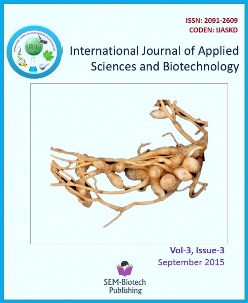Evaluation of Quality Protein Maize and Drought Tolerant Maize in Far Western Hills of Nepal
DOI:
https://doi.org/10.3126/ijasbt.v3i3.12915Keywords:
genotypes, grain yield, kg/ha, drought, resistance, significant’, traitsAbstract
The coordinated varietal trial of quality protein maize was carried out in research station of regional agricultural research station, Doti during 2011/12 and 2012/13. A total of fourteen entries including standard and local checks were included in the experiment of both years. Out of tested entries of the year 2011/12, S99TLYQ-A produced the highest grain yield (2814 kg/ha) followed by SO3TLYQ-AB-01 (2765 kg/ha) and SO3TLYQ-AB-02 (2293 kg/ha). MSTATC software was used in data analysis. Flowering days, plant height and grain yield due to genotypes was found significant at 1-5% level. Amongst the tested entries include in the experiment of the year 2012/13, S99TLYQ-AB recorded the highest grain yield (6006 kg/ha) followed by SO3TLYQ-AB-01 (5409 kg/ha) and S99TLYQ-A (5330 kg/ha). There was significant difference in flowering days, plant height, ear height and grain yield due to genotypes at 1-5 % level. Combined analysis over year was also carried out. Genotypes SO3TLYQ-AB-01 (4087 kg/ha), S99TLYQ-A (4072 kg/ha) and S99TLYQ-AB (3750 kg/ha) identified as promising genotypes for lower hills and river basin agro-environment of far western hills. Similarly, experiment on selection of drought tolerance maize genotypes was also carried out at this research station during 2011/12 and 2012/13. Total 105 genotypes of maize were planted for selection of drought tolerance maize genotypes during 2011/12 and it was replicated twice. Quantitative and qualitative traits were recorded for screening against drought. Out of the genotypes included in the experiment, Manakamana-4 was found super variety in terms of grain yield (4561 kg/ha), leaf senescence (1) and leaf roll (1). Statistically, plant height, ear height, flowering days and leaf senescence due to genotypes were found significantly different. Total eight genotypes were selected for second year's drought tolerance genotypes selection experiment and were planted in three replications. Out of the eight genotypes included in the experiment, Upahar (6897 kg/ha), TLBRSO7F16 (6216 kg/ha) and BLSBSO7F12 (6215 kg/ha) were found superior in terms of grain yield.
Int J Appl Sci Biotechnol, Vol 3(3): 387-391




